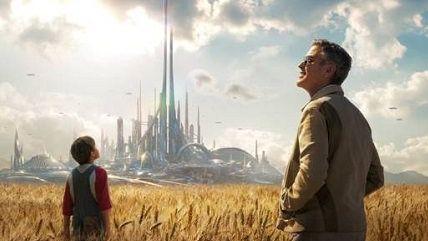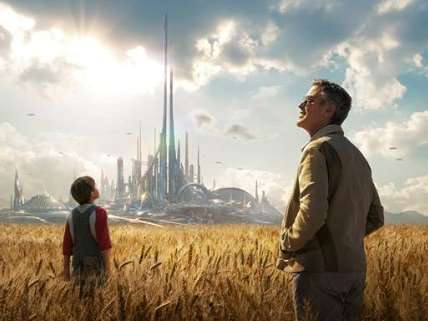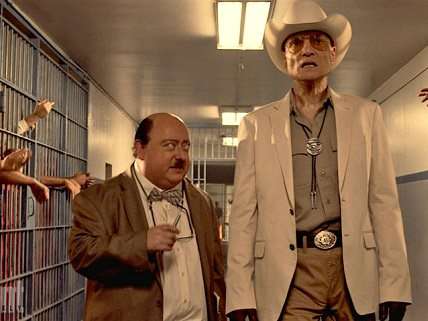Movie Reviews: Tomorrowland and The Human Centipede III (Final Sequence)
Into the future with George Clooney, into the dumper with Tom Six's last trash fest.


Tomorrowland has so much going for it that you wonder, as you watch it stretch past the two-hour mark, why it isn't actually going anywhere—or anywhere you feel able to go with it, anyway. The director, Pixar genius Brad Bird, is a master of both digital animation (The Incredibles, Ratatouille) and complex live action (Mission: Impossible – Ghost Protocol). The top-billed lead, George Clooney, is a star of well-established charm. And the script that Bird has fashioned with cowriter Damon Lindelof (Lost, alas) tells a cute sci-fi story with a bright shiny message of a sort not much heard in these days of dark movie dystopias.
All of which sounds perfect for this Disney film's target PG audience, and you can't help hoping it is. But the story is a little jumbled right from the start. It begins with middle-aged inventor Frank Walker (Clooney) addressing the camera over protests from a young woman named Casey Newton (Britt Robertson). These two have tales to tell—very similar tales. After some introductory squabbling that's confusing at this early point, Frank goes first.
Back in his childhood, young Frank (played by Thomas Robinson) visited the 1964 World's Fair in New York, bringing with him a newly constructed jetpack that he hoped to enter in some sort of junior-inventor's contest. After being turned away by a condescending contest official named Nix (a glowering Hugh Laurie), Frank encountered a mysterious little girl called Athena (Raffey Cassidy). She admired Frank's can-do spirit (asked why he made his jetpack he said, "I got tired of waiting for someone else to make it for me"), and she gave him an odd little pin with a large letter T on it. This pin transports Frank to Tomorrowland, a city of classic futurism: gleaming chrome towers, whispering hover-trains, saucer-y aircraft cruising through the skies. Young Frank thought he'd found a cool new home. But then he angered Tomorrowland's mayor (or something--it's Nix again), and soon found himself banished. Back in the present day, he's been nursing his bitterness ever since.
We miss Tomorrowland immediately, and soon we're missing Clooney, too—he spends the next hour or so back in his trailer while Robertson's Casey takes over the narrative. (Which is fine—she and the freckly Cassidy are the real stars of the show.) We grow antsy watching Florida girl Casey attempting to sabotage the dismantling of a NASA launch site where her father (Tim McGraw) is employed. But then Athena reappears, gives Casey one of those Tomorrowland pins, and the story gathers speed, with a gang of black-clad robot guys weighing in to keep things hopping.
A number of wonderful scenes follow. There's some frantic action at a sinister memorabilia shop (run by Kathryn Hahn and Keegan-Michael Key). And when the action switches to Paris, Bird engineers an Eiffel Tower sequence that makes CGI spectacle seem wholly fresh again. Back in Tomorrowland, there's a passing shot—no more than a few seconds—of a series of diving pools that has a lovely offhand enchantment.
But these scenes are interspersed with passages of unexciting exposition that prevent them from melding into a satisfying whole. And all of the Disneyism on display grows a little oppressive (we see both Disneyland and Disney World, and there's a scene set in the It's a Small World water ride that Disney introduced at that 1964 World's Fair). There's also an odd, creepy vibe given off by the relationship between Frank and Athena. He fell in love with her as a boy; now he's a grown man and she's still 12, but his continuing infatuation is obvious.
The movie is really undone by its overbearing message, which is admirable in its space-age optimism but trite in its effect. Tomorrowland, we learn, was built by the best and brightest of the human race (surely Ayn Rand has a seat on the city council) as an escape from the collapsing world of the present day. But Casey believes that earthly doom is not foreordained—that if we just look on the positive side and set about finding solutions for contemporary problems, everything will work out fine. It's hard to imagine any rational person disagreeing with this point of view. But when the most pressing problems to be overcome are explicitly listed (they range from global warming to "the obesity epidemic"), we feel a familiar political wind wafting in. Are we really in Tomorrowland, or someplace closer to Hollywood?

The Human Centipede III (Final Sequence)
If he has accomplished nothing else—and Lord knows, he hasn't—Dutch filmmaker Tom Six has managed to give political incorrectness a bad name. Six's Human Centipede trilogy, of which Final Sequence is the concluding installment, hammers away one ostentatiously gross idea—the stitching together of human victims, mouth to anus, to form a "centipede" with one common gastrointestinal system. The initial film in this series, the 2009 First Sequence, featured three such victims, and was an effectively appalling midnight movie. The unnecessary followup, Full Sequence, shot in black and white and upping the segment count to 12, was peerlessly grotty and already boring. Now, with Final Sequence, Six enters a new realm of dismal tedium.
Dieter Laser, the serpent-faced German actor who played the mad doctor in the first film, is back, this time playing Bill Boss, the demented warden of a desert prison so vile that the governor of whatever state we're in is determined to shut it down. (The governor is played with check-cashing detachment by Eric Roberts, an actor who was once nominated for an Oscar.) The warden's accountant (Laurence R. Harvey, the tub-like star of the second film) has an idea to preserve their jobs. As a fan of the first two Centipede films, he suggests pacifying the violent prison populace by sewing the inmates into a super-centipede—200 segments long!
Also passing through this mess are cheery ex-pornstar Bree Olson, who must surely be contemplating a return to her old day job, and Six himself, who swans through the proceedings with smirky irrelevance. Since the big centipede reveal is held back until the picture's end, the movie expends most of its 102 minutes on witless affronts. There are graphic gags about female genital mutilation, male rape and castration, and, inevitably, much worse. The intended effect here is rule-breaking shock; but the movie's execution is too inept to be anything more than numbing.
Six promotes himself as a master of cinematic transgression, but it's transgression at the level of simian poo-flinging. He has little talent for horror—these are not scary movies—and none at all for dialogue, camera placement or any other skills normally associated with competent filmmaking. And yet he's already embarked on another movie, something called The Onania Club. You can guess what it's about, and be bored in advance.


Show Comments (60)